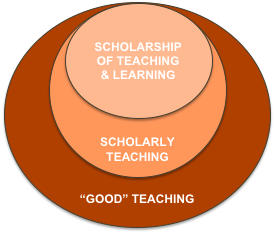Welcome
Welcome to this workshop on Research in Teaching and Learning I!
This workshop has been adapted from a graduate-level course. Therefore, there may be some references activities and assessment. You can interact with these research and reflection-based activities individually to support your understanding of the content.
In this module, we will discuss the scholarship of teaching and learning (SoTL), review relevant literature about the topic, and think about how the steps and process to starting a SoTL project.
Learning Outcomes
By the end of this module, you should be able to
- Distinguish between good teaching, scholarly teaching, and the scholarship of teaching and learning (SoTL)
- Locate disciplinary-relevant teaching literature that you can continue to consult as you develop as a scholarly teacher and/or engage in SoTL
- Consider five key principles of good practice in SoTL as you begin to imagine conducting your own SoTL project
Teaching and learning researchers often distinguish between good teaching, scholarly teaching, and the scholarship of teaching and learning (SoTL).

You can learn more about how others have articulated this distinction by reviewing the resources below.
The Center for Engaged Learning produced this article, SoTL vs. Scholarly Teaching which features a video (see below) with interviewed SoTL scholars offering key distinctions between Scholarship of Teaching and Learning vs. Scholarly Teaching.
The MacPherson Institute, formerly the Center for Leadership in Learning at McMaster University has produced the Research on Teaching & Learning Guidebook which provides an introduction to SoTL research.
There are also emerging conversations about the similarities and differences between the Scholarship of Teaching and Learning (SoTL) and Educational Research, Disciplinary-Based Educational Research, Learning Science, Health Professions Education, and several other terms for research into teaching and learning in postsecondary education. McMaster University uses the term ‘research on teaching’ to describe this work. Read Research on Teaching and Learning at McMaster University: A Discussion for the rationale for this term.
- Learn more about these overlaps and distinctions by reading SoTL, ER, and DBER: Thoughts Inspired by a Twitter Conversation, a blog posted on The SoTL Advocate, written by Jennifer Friberg, the Cross Endowed Chair in SoTL and Professor of Communication Sciences and Disorders at Illinois State University.
Note: While this module uses the language of SoTL, you may hear other terms within your discipline and among colleagues.
After reviewing the above material, reflect on the following questions:
- How would you distinguish good teaching, scholarly teaching, and the scholarship of teaching and learning?
- Where might your current teaching approach/practice fit within these categorizations?
- What might motivate you to further engage in scholarly teaching and/or scholarship of teaching and learning?
Scholarly Teaching: Locating the Literature
The first step to becoming a scholarly teacher and/or to conducting scholarship of teaching and learning is to engage directly with the teaching literature! There are many places to look for SoTL-specific research:
- Multidisciplinary SoTL journals
- ERIC (Education Resources Information Centre) database
- Directory of discipline-specific teaching journals
Activity
Try out the activity below to get started with your own SoTL research. You can record your answers in the interactive activity and export your answers, or download the word document and fill it in.
- First, using Kennesaw State University’s Teaching Journals Directory page, identify 2-3 teaching journals in your area of study (e.g. history, social work, biology).
- Then, identify a teaching topic of interest and compose a search for 2-3 related articles. Focus on selecting articles that are:
- Relevant to you and your teaching context, and
- Can assist you in becoming a scholarly teacher and/or exploring an area of potential interest for a future SoTL project
- You may elect to search disciplinary-specific journals or take a more interdisciplinary approach
- Record your answers in the interactive activity below, or the downloadable hand out.
Principles of Good Practice in SoTL
Nancy Chick (2015) defines SoTL as follows:
- The scholarship of teaching and learning (SoTL) is a synthesis of teaching, learning, and research in post-secondary education that brings a scholarly lens—the curiosity, the inquiry, the rigour, the disciplinary perspectives, and the attention to larger conversations—to what happens when learning happens (or doesn’t).
- We say that SoTL brings a scholarly approach because it begins with intellectual curiosity, is conducted deliberately and systematically, is grounded in an analysis of relevant evidence, and results in findings shared with peers to be reviewed and to expand a knowledge base.
Peter Felten’s (2013) “Principles of good practice in SoTL” has become an important touchstone for undertaking and assessing work in the field. In this paper, Felten proposes 5 principles for the Scholarship of Teaching and Learning:
- Inquiry focused on student learning
- Grounded in context
- Methodologically sound
- Conducted in partnership with students
- Appropriately public.
For more information on these principles, read Principles of Good Practice in SoTL by Peter Felten and watch the accompanying film clips below, related to the topic.
Inquiry focused on student learning; grounded in context; methodologically sound
- Taxonomy of Questions in SoTL (Is it working? What went on? What would it look like? Theory/concept building)
- SoTL Research in English – The Relevance of Teaching Poetry Today
- SoTL Research in Nursing – Teaching Pain Management through Simulation
- SoTL Research in the Culinary Arts – Online, Face-to-Face or Hybrid Learning?
Conducted in partnership with students
Appropriately public
List of teaching conferences, journals, blogs for sharing teaching-related scholarship.
Use your the interactive document or download handout in the last section, to reflect on how these 5 principles might apply to your own potential SoTL project.
Sources
(p. 6-7) Fenton, N. E. & Szala-Meneok, K. (2011). Research on Teaching & Learning Guidebook. Centre for Leadership in Learning, McMaster University.https://mi.mcmaster.ca/app/uploads/2019/07/Research-on-TL-Guidebook.pdf
Center for Engaged Learning. (2013). SoTL vs. Scholarly Teaching. https://www.centerforengagedlearning.org/studying-engaged-learning/sotl-vs-scholarly-teaching/
Friberg, J. (2018). SoTL, ER, and DBR: Thoughts Inspired by a Twitter Conversation. The SoTL Advocate.https://illinoisstateuniversitysotl.wordpress.com/2018/11/27/sotl-er-and-dber-thoughts-inspired-by-a-twitter-conversation/
Felten, P. (2013). Principles of good practice in SoTL. Teaching and Learning Inquiry, 1(1), 121-125.https://www.jstor.org/stable/10.2979/teachlearninqu.1.1.121
